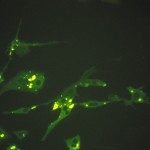Link to Pubmed [PMID] – 12885898
J. Virol. 2003 Aug;77(16):8793-800
We previously developed a model for studies on hantavirus host adaptation and initiated genetic analysis of Puumala virus variants passaged in colonized bank voles and in cultured Vero E6 cells. With the data presented in this paper, the sequence comparison of the wild-type and Vero E6-adapted variants of Puumala virus, strain Kazan, has been completed. The only amino acid substitution that distinguished the two virus variants was found in the L protein, Ser versus Phe at position 2053. Another mutation found in the L segment, the silent transition C1053U, could result from the selection of a variant with altered L RNA folding. Nucleotide substitutions observed in individual L cDNA clones, most of them A–>G and U–>C transitions, suggested that the population of L RNA molecules is represented by quasispecies. The mutation frequency in the L segment quasispecies appeared to be similar to the corresponding values for the S and M quasispecies. Analysis of the cDNA clones with the complete S segment sequences from passage 20 confirmed our earlier conclusion that the cell-adapted genotype of the virus is represented mostly by variants with mutated S segment noncoding regions. However, the spectrum of the S segment quasispecies appeared to be changing, suggesting that, after the initial adaptation (passages 1 to 11), the viral population is still being driven by selection for variants with higher fitness.

